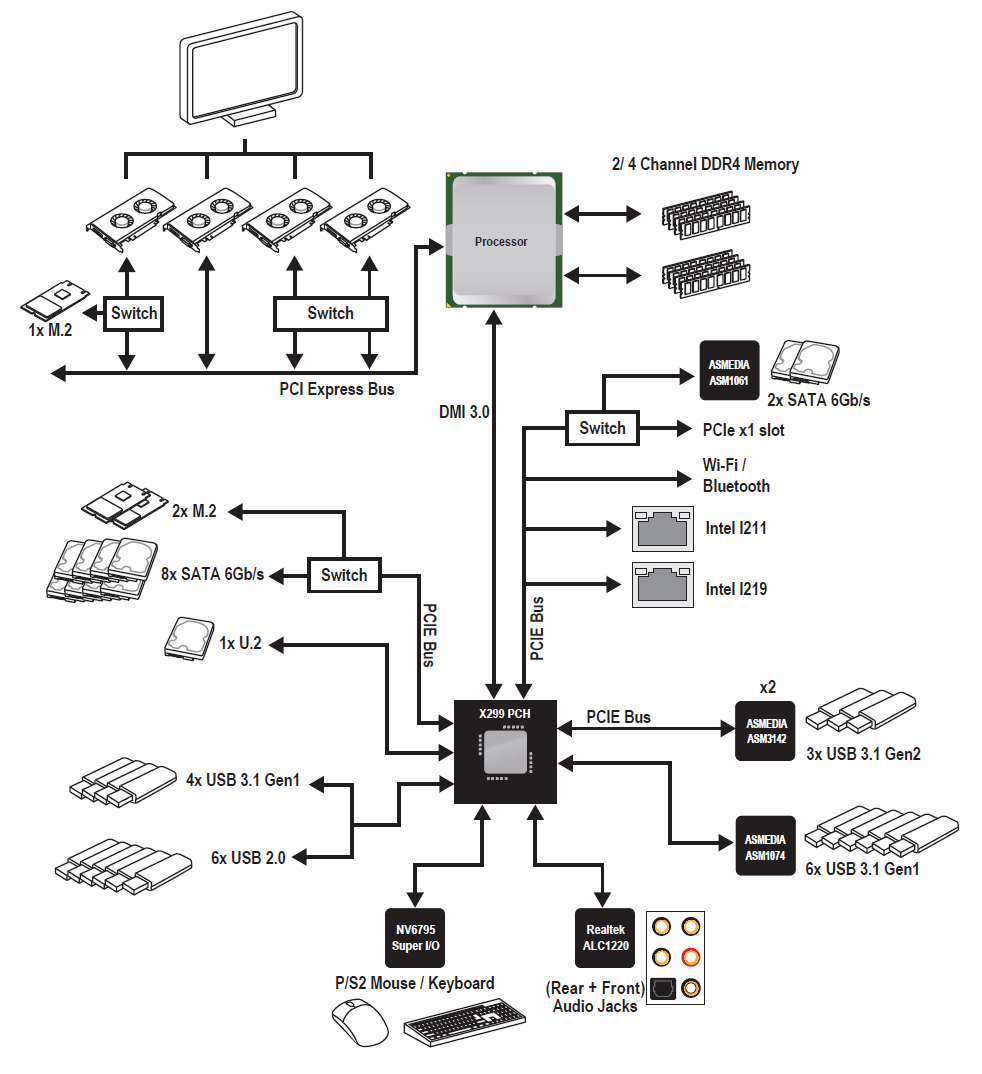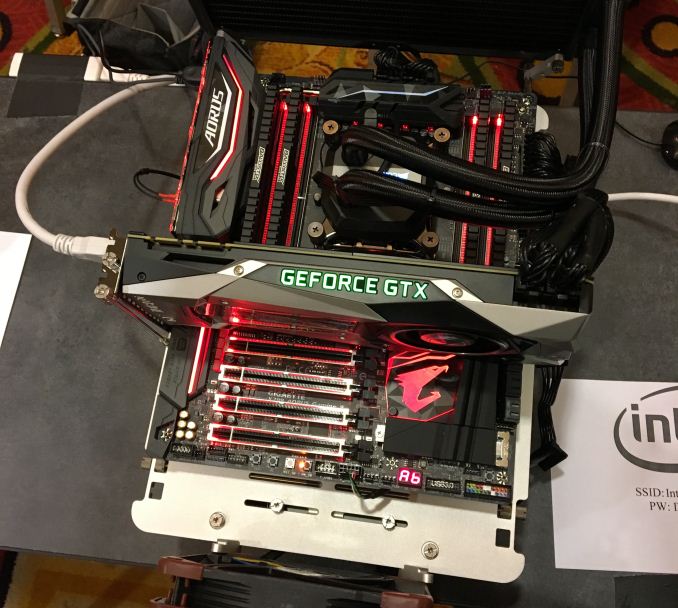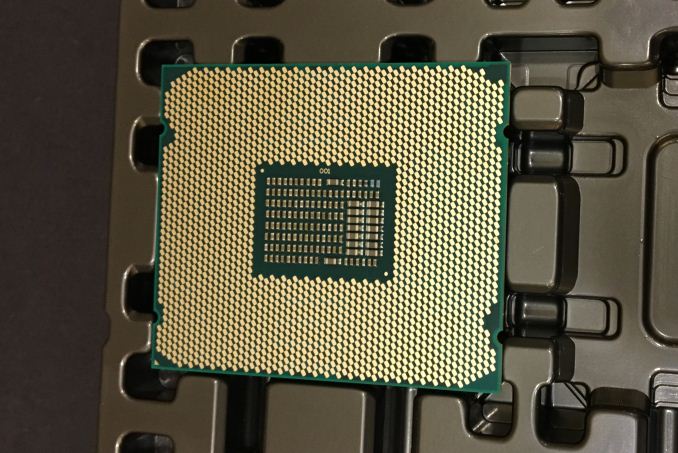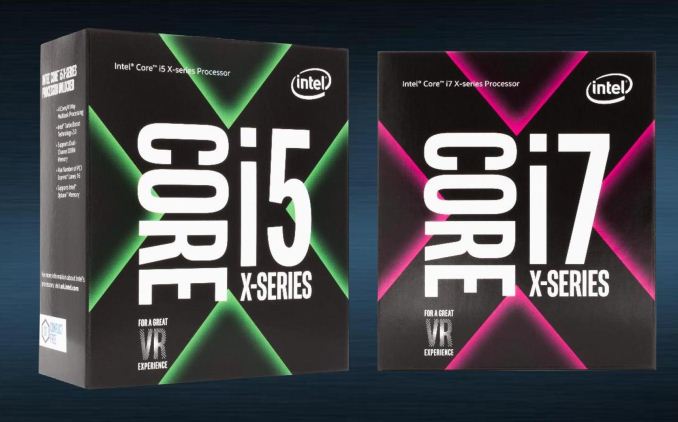The Intel Kaby Lake-X i7 7740X and i5 7640X Review: The New Single-Threaded Champion, OC to 5GHz
by Ian Cutress on July 24, 2017 8:30 AM EST- Posted in
- CPUs
- Intel
- Kaby Lake
- X299
- Basin Falls
- Kaby Lake-X
- i7-7740X
- i5-7640X
Navigating the X299 Minefield: Kaby Lake-X Support
When building a platform, keeping it limited to one particular type of product makes it simple and easy to understand, at the expense of flexibility. The idea of flexibility is one that Intel and AMD have experimented with in the past, enabling users to stay on the same underlying platform and upgrade in future generations, but with X299, Intel is taking a large step forward in support. This is both a good and bad thing, depending on how different the support for the different generations needs to be. In this context, Skylake-X and Kaby Lake-X are like chalk and cheese, which can present a headache for users new to building systems. It has caused some minor headaches with system builders and motherboard manufacturers already.
To recap, the three elements of the Basin Falls platform launch were the motherboards/X299 chipset, the SKL-X processors and the KBL-X Processors.
X299: What Is It?
The X299 chipset supports the new Skylake-X and Kaby Lake-X processors, and like the Z170 chipset and Z270 chipset counterparts on the mainstream consumer line, are basically big PCIe switches. One of the issues with the older X99 chipset was its limited capabilities, and inability to drive many PCIe devices – this changes with the big switch mentality on X299. For the DMI 3.0 link going into the chipset (basically a PCIe 3.0 x4), the chipset has access to up to 24 PCIe 3.0 lanes for network controllers, RAID controllers, USB 3.1 controllers, Thunderbolt controllers, SATA controllers, 10GbE controllers, audio cards, more PCIe slot support, special controllers, accelerators, and anything else that requires PCIe lanes in either an x4, x2 or x1 link.
The total uplink is limited by the DMI 3.0 link, but there will be very few situations where this is saturated. There are a few limits to what support is available (some ports are restricted in what they can handle), and only three PCIe 3.0 x4 drives can use the in-built PCIe RAID, but this should satiate all but the most hardcore enthusiasts.
Skylake-X CPUs: Coming in Two Stages
The Skylake-X family of processors for Basin Falls comes in two stages, based on the way the processors are developed. Normally HEDT processors are cut down versions of enterprise processors, usually through restricting certain functions, but the enterprise processors are typically derived from three different silicon layouts during manufacturing. Internally Intel call these three layouts the LCC (low core-count), HCC (high core-count) and XCC (extreme core-count), based on the maximum number of cores they support. Nominally Intel does not disclose which silicon layout they use for which processors, though it is usually straight forward to work them out as long as Intel has disclosed what the configurations of the LCC/HCC/XCC dies are. In this case, Intel has officially left everyone guessing, but the point here is that historically Intel only uses the LCC silicon from the enterprise line for its consumer desktop processors.
In previous generations, this meant either a 6, 8 or 10 core processor at the top of the stack for consumers, with lower core count models being provided by disabling cores (this is a complex topic involving the quality of the manufacturing process and determining voltage/frequency in a process called binning. We’ve covered it before, but it’s something all manufacturers have to do to get good yields as making processors isn’t a perfect process). Each year we expected one of two things: the top-end SKU either gets more frequency, less power, or more cores, and as such the march of progress has been predictable. If you had asked us two months ago, we would have fully expected Skylake-X to top out with LCC silicon at 10 or 12 cores, depending on how Intel was planning the manufacturing part.
So the first element of Intel’s launch is the LCC processors, running up to 10 cores. We previously published that the LCC silicon was 12 cores, but we can now show it is 10 – more on that later. The three Skylake-X CPUs launching today are using LCC silicon with 6, 8 or 10 cores as the Core i7-7800X, Core i7-7820X and Core i9-7900X respectively. Intel is further separating these parts by adjusting the level of official supported DRAM frequency, as well as the PCIe lanes.
The second element to the Skylake-X launch is the one that has somewhat surprised most of the industry: the launch will contain four processors based on the HCC silicon. Technically these processors will not be out until Q4 this year (one SKU coming out in August), and the fact that Intel did not have frequency numbers to share when announcing these parts show that they are not finalized, calling into question when they were added to the roadmap (and if they were a direct response to AMD announcing a 16-core part for this summer). We’ve written a detailed analysis on this in our launch coverage, but Intel is set to launch 12, 14, 16 and 18-core consumer level processors later this year, with the top part running a tray price (when you buy 1k CPUs at a time) of $1999, so we expect the retail to be nearer $2099.
It should be noted that due to a number of factors, the Skylake-X cores and the communication pathways therein are built slightly differently to the consumer version of Skylake-S, which is something discussed and analyzed in our Skylake-X review.
Kaby Lake-X: The Outliers
The final element to the Basin Falls launch is Kaby Lake-X. This is also an aspect of the Basin Falls platform that deviates from the previous generations. Intel’s HEDT line has historically been one generation behind the mainstream consumer platform due to enterprise life cycles as well as the added difficulty of producing these larger chips. As a result, the enterprise and HEDT parts have never had the peak processing efficiency (IPC, instructions per clock) of the latest designs and have sat in the wings, waiting. By bringing the Kaby Lake microarchitecture to HEDT in the form of a Core i7 and a Core i5, this changes the scene, albeit slightly.
Rather than bringing a new big core featuring the latest microarchitecture, Intel is repurposing the Kaby Lake-S mainstream consumer silicon, binning it to slightly more stringent requirements for frequency and power, disabling the integrated graphics, and then putting it in a package for the high-end desktop platform. There are still some significant limitations, such as having only 16 PCIe 3.0 lanes and dual channel memory which might exclude it from the traditional designation of being a true HEDT processor; however Intel has stated that these parts fill a request from customers to have the latest microarchitecture on the HEDT platform. They also overclock quite well, which is worth noting.
The Kaby Lake-X parts will consist of a Core i7 and Core i5, both of which are quad core parts, with the i7 supporting hyperthreading.
Problem Number 1: PCIe Layouts
Users can choose an X299 motherboard and a SKL-X processor, or an X299 motherboard with a KBL-X processor. Every X299 motherboard should have to support both, and it is the level of support that each processor needs that makes it a more difficult task than one might imagine. The obvious difference between the two is the number of PCIe lanes, and where they come from.
KBL-X processors have 16 PCIe 3.0 lanes from the processor, coming from a single PCIe root complex, and these can be bifurcated into x8/x8 or x8/x4/x4 depending on what the motherboard manufacturer wants to implement.
SKL-X processors have either 28 PCIe 3.0 lanes or 44 PCIe 3.0 lanes, depending on which model you buy, and these can come from up to three PCIe x16 root complexes (some complexes will be limited to fit the number). Each one can still be bifurcated into x8/x4/x4, but typically one would expect one PCIe root complex to fill the first x16, and then the next x16 comes from the second root complex, which will either be filled by x8 on the 28-lane processors or x16 on the 44-lane processors. The PCIe lanes can also fly off to support other things, such as storage or Ethernet controllers.
The issue here is that motherboard manufacturers have to design for all three different PCIe lane counts. It is very easy to design a motherboard for SKL-X, and then when a user has a KBL-X processor half the features do not work. This is going to be true for a lot of PCIe slots, and in order to manage all this, manufacturers have to equip the motherboards with PCIe switches to make sure everything is routed correctly for both CPUs, and these switches add cost to the platform. If there were two different platforms, there would not be this added per-board cost (but vendors would have to build two boards instead, each one easier to design).

Chipset Diagram of MSI's X299 XPower Gaming AC, their high-end MB
Aside from the PCIe slots, storage is also going to become an issue. With the previous generation of X99, we started to see M.2 based PCIe storage coming from the processor – guaranteeing no limit in uplink bandwidth, especially when RAID was used. For the new X299 platform, because of KBL-X support, most M.2 slots will be derived from the chipset, adding a small amount of latency but also somewhat limited by the chipset-to-CPU uplink limit of PCIe 3.0 x4. Using two fast M.2 drives in RAID via the chipset will be limited by its own connection. Motherboard vendors know this, and they want to have as many features supported as much as possible in all situations, and so finding a motherboard with a CPU-derived M.2 slot is going to be a rare thing indeed.
The solution to some of this is to have specific motherboards for each set of CPUs. Sure, both CPUs will still work in the motherboard, but when using the wrong family for the CPU design, functionality is going to be severely limited. ASUS has already posted some details about its new Extreme motherboard for X299, with the disclaimer ‘not designed for Kaby Lake-X CPUs’ because the features on board are aimed at SKL-X customers only. We might see more of this filtering through.
There’s also the DRAM: KBL-X is a dual channel design, SKL-X is quad-channel. On an eight-DRAM slot X299 motherboard, only four are operational for KBL-X, wasting board space. The primary four slots for KBL-X are different to SKL-X as well, just in case a user needs to move DRAM around. If a user buys an X299 motherboard with only four slots, chances are only two will work with KBL-X.
One argument here is that a user can upgrade from KBL-X to SKL-X later, or to the beefier KBL-X CPUs launched next generation.
Problem Number 2: Power
Skylake and Kaby Lake are different x86 microarchitectures – the KBL core design was meant to be an ‘optimization’ implementation of Skylake, hitting a few loose hanging fruit and using an updated 14nm process to give better power consumption and better voltage/frequency response from the silicon. There isn’t so much drastic change in the cores, but there is in how the power is delivered.
Skylake-X uses an integrated voltage regulator, or IVR. If you recognize the term, then that is because Intel launched its Broadwell based CPUs with a FIVR, or fully-integrated voltage regulator. Skylake-X does not go all-in like Broadwell did, but for some of the voltage inputs to the CPU, the processor takes in a single voltage and splits it internally, rather than relying on the external circuitry of the motherboard to do so. This affords some benefits, such as consistency in voltage delivery and to a certain extent, some efficiency power gains, and it should simplify the motherboard design - unless you also have to design for non-IVR CPUs, like Kaby Lake-X.
Kaby Lake-X is more of a typical power delivery design, with all the required voltages being supplied by the motherboard. That means that the motherboard has to support both types of voltage delivery, and also adjust itself at POST if a different CPU has been placed in. This obviously adds to the boot time to check if it is the same, but it does require some voltages to be moved around, as too high a voltage can kill a processor. We’ve already killed one.
Specifically, the VRIN voltage on Skylake-X needs to be 1.8V input into the processor for the IVR to work. The same setting on Kaby Lake-X needs to be 1.1 volts for VCCIO. If the motherboard originally had a SKL-X processor in it and does not detect when a KBL-X processor is in, then the motherboard will supply 1.8 volts into the KBL-X rail and the chip will soon die.
When we received samples for SKL-X and KBL-X, we were told by our motherboard partners that if we were switching between the two CPUs, we would have to flush the BIOS. This involves removing AC power when switched off, and holding the Clear CMOS button for 30-60 seconds to train the capacitors and essentially reset the BIOS to default, so it could then detect which CPU was in play before applying full voltages.
We did this, and still ended up with a dead Kaby Lake i7-7740X. There is now a lump of sand in my CPU box. The interesting thing is that this CPU did not die instantly: we started SYSMark, which involves several reboots during the initial preparation phase. On about the 4th reboot, the system stuck with the BIOS code 0d. Nothing I did was able to go beyond this code, and I put in our Kaby i5 and that ran fine. I put in SKL-X and that ran fine. I put the Kaby i5 in and that ran benchmarks fine. It would appear that our initial Kaby i7 did not have much headroom, and we had to get a replacement for some of the benchmarks.
Incidentally, we also had an i9-7900X die on us. That seems to be unrelated to this issue.
So The Solution?
Motherboard manufacturers have told us that there may be chip-specific motherboards out there in the future. But as it stands, users looking at KBL-X would save a lot of money (and headache) staying with Z270, as the motherboards are cheaper and more streamlined for a Kaby Lake design. Users looking at the top Skylake-X CPUs have nothing to worry about – unless the user really wanted PCIe storage from the CPU. In this case the user will have to find the one or two motherboards that support it, or invest in a PCIe to M.2 riser card and enable it this way – as long as the user puts it into a CPU-based PCIe slot.
So why even bother testing KBL-X if it comes across so downbeat on the platform situation? KBL-X still warrants testing, as the highest frequency processor Intel has released on the latest CPU microarchitecture. As mentioned above, overclocking on KBL-X seems very good, and some users will require the peak single thread performance possible. The argument is more the fact that some of these issues can complicate the platform, reducing accessibility to new builders and causing extra work/time/headaches for motherboard manufacturers and system builders. The issues above are not a significant barrier for any user willing to put in some time to ensure what they buy is suited for their workload.













176 Comments
View All Comments
Santoval - Tuesday, July 25, 2017 - link
That is not how IPC works, since it explicitly refers to single core - single thread performance. As the number of cores rises the performance of a *single* task never scales linearly because there is always some single thread code involved (Amdahl's law). For example if your task has 90% parallel and 10% serial code its performance will max out at x10 that of a single core at ~512 cores. From then on even if you had a CPU with infinite cores you couldn't extract half an ounce of additional performance. If your code was 95% parallel the performance of your task would plateau at x20. For that though you would need ~2048 cores. And so on.Of course Amdahl's law does not provide a complete picture. It assumes, for example, that your task and its code will remain fixed no matter how many cores you add on them. And it disregards the possibility of computing distinct tasks in parallel on separate cores. That's where Gustafson's Law comes in. This "law" is not concerned with speeding up the performance of tasks but computing larger and more complex tasks at the same amount of time.
An example given in Wikipedia involves boot times : Amdahl's law states that you can speed up the boot process, assuming it can be made largely parallel, up to a certain number of cores. Beyond that -when you become limited by the serial code of your bootloader- adding more cores does not help. Gustafson's law, on the contrary, states that instead of speeding up the boot process by adding more cores and computing resources, you could add colorful GUIs, increase the resolution etc, while keeping the boot time largely the same. This idea could be applied to many -but not all- computing tasks, for example ray tracing (for more photorealistic renderings) and video encoding (for smaller files or videos with better quality), and many other heavily multi-threaded tasks.
Rickyxds - Monday, July 24, 2017 - link
I just agree XD.Diji1 - Wednesday, July 26, 2017 - link
"Overall speed increase 240%."LMAO. Ridiculous.
Alistair - Wednesday, July 26, 2017 - link
No reason to laugh. I compared the 6600k vs the Ryzen 1700. 1 year speed increase of 144 percent (2.44 times the speed). Same as this: 1135 vs 466 points.http://cpu.userbenchmark.com/Compare/Intel-Core-i5...
Dr. Swag - Tuesday, July 25, 2017 - link
I disagree, best value is 1600 as it oces as well as 1600x, comes with a decent stock cooler, and is cheaper.vext - Monday, July 24, 2017 - link
Interesting article but it seems intended to play down the extremely bad press x299 has received which is all over the internet and Youtube.Once you get past Mr. Cuttress' glowing review, it's clear that the I5-7640x is not worth the money because of lackluster performance, the I7-7740X is marginally faster than the older 7700k, and the I7-7800x is regularly beaten by the 7740X in many benchmarks that actually count and is a monstrously inefficient energy pig. Therefore the only Intel CPUs of this batch worth buying are the 7700k/7740x, and there is no real advantage to x299. In summary, it doesn't actually change anything.
It's very telling that Mr. Cutress doesn't comment on the absolutely egregious energy consumption of the 7800x. The Test Bed setup section doesn't list the 7800x at all. The 7840x and 7740x are using a Thermalright True Copper (great choice!) but no info on the 7800x cooler. Essentially, the 7800x cameo appearance is only to challenge the extremely strong Ryzen multi-threaded results, but its negative aspects are not discussed, perhaps because it might frighten people from x299. Tsk, tsk. As my 11 year old daughter would say "No Fair." By the way, the 7800x is selling for ~ $1060 right now on Newegg, not $389.
Proudly typed on my Ryzen 1800x/Gigabyte AB350 Gaming 3. # ;-)
Ian Cutress - Monday, July 24, 2017 - link
You may not have realised but this is the Kaby Lake-X review, so it focuses on the KBL-X parts. We already have a Skylake-X review for you to mull over. There are links on the first page.mapesdhs - Monday, July 24, 2017 - link
Nevertheless, the wider picture is relevant here. The X299 platform is a mess. Intel is aiming KL-X at a market which doesn't exist, they've locked out features that actually make it useful, it's more power hungry, and a consumer needs a lot of patience and plenty of coffee to work out what the heck works and what doesn't on a mbd with a KL-X fitted.This is *exactly* the sort of criticism of Intel which should have been much stronger in the tech journalism space when Intel started pulling these sorts of stunts back with the core-crippled 3930K, heat-crazy IB and PCIe-crippled 5820K. Instead, except for a few exceptions, the tech world has been way too forgiving of Intel's treading-on-water attitude ever since SB, and now they've panicked in response to Ryzen and released a total hodgebodge of a chipset and CPU lineup which makes no sense at all. And if you get any disagreement about what I've said by anyone at Intel, just wave a 4820K in their face and say well explain this then (quad-core chip with 40 PCIe lanes, da daa!).
I've been a big fan of Z68 and X79, but nothing about Intel's current lineup appeals in the slightest.
serendip - Tuesday, July 25, 2017 - link
There's also the funny bit about motherboards potentially killing KBL-X CPUs if a Skylake-X was used previously.What's with Intel's insane product segmentation strategy with all the crippling and inconsistent motherboard choices? It's like they want to make it hard to choose, so buyers either get the cheapest or most expensive chip.
Haawser - Tuesday, July 25, 2017 - link
'EmergencyLake-X' is just generally embarrassing. Intel should just find a nearby landfill site and quietly bury it.